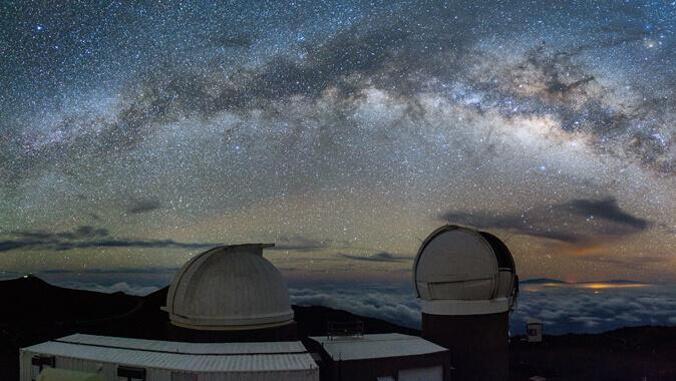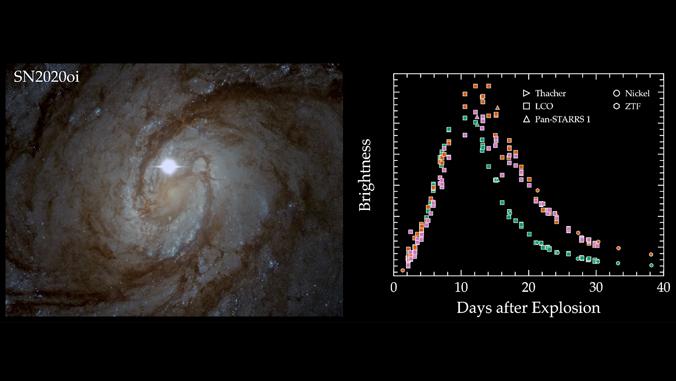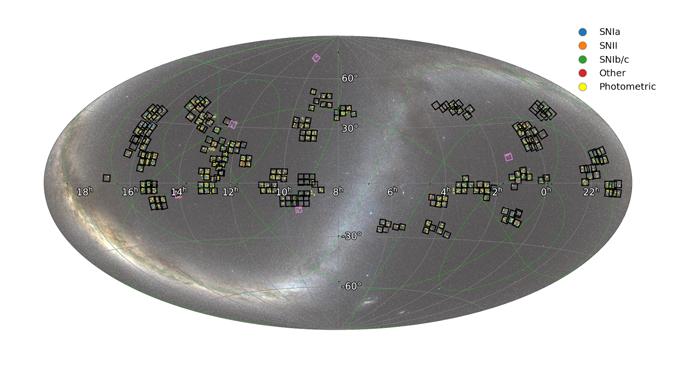Maui’s Pan-STARRS telescope helps log largest catalog of exploding stars

The Pan-STARRS telescope atop Haleakalā on Maui has collected data that is now being released as the largest catalog of exploding stars. The data from the University of Hawaiʻi Institute for Astronomy’s Pan-STARRS telescope contains three years of research and is now publicly available via the Young Supernova Experiment.
The project, which began in 2019, surveyed more than 1,500 square degrees of sky every three days, and discovered thousands of new cosmic explosions and other astrophysical transients, dozens of them just days or hours after exploding. The relatively nearby supernovae are also referred to as colossal explosions of stars.
Scientists say celestial phenomena that change with time such as exploding stars, mysterious objects that suddenly brighten and variable stars are a new frontier in astronomical research. The research is made possible with telescopes that can rapidly survey the sky revealing thousands of these objects.

The newly-released data contains information on nearly 2,000 supernovae and other luminous variable objects with observations in multiple colors. It is also the first to extensively use the multi-color imaging to classify the supernovae and estimate their distances, according to a UH news release.
Astrophysicists use large imaging surveys—systematic studies of large areas of the sky over time—and different parts of the electromagnetic spectrum for many scientific goals. Some are used to study distant galaxies and how they evolve over cosmic time, or look at specific regions of the sky that are especially important, such as the Andromeda Galaxy.

“Pan-STARRS produces a steady stream of transient discoveries, observing large areas of the sky every clear night with two telescopes,” said Mark Huber, a senior researcher at IfA in the release. “With over a decade of observations, Pan-STARRS operates one of the best calibrated systems in astronomy, with a detailed reference image of the static sky visible from Haleakalā. This enables rapid discovery and follow-up of supernovae and other transient events, well suited for programs like YSE to build up the sample required for analysis and this significant data release.”
YSE is designed to find energetic astrophysical “transient” sources such as supernovae, tidal disruption events and kilonovae (extremely energetic explosions). These transients evolve quickly, rising to their maximum brightness and then fading away after a few days or months.
The images from Pan-STARRS are transferred to UH’s Information Technology Center for initial processing and scientific calibration by the Pan-STARRS Image Processing Pipeline. Higher-level processing, detailed analysis and storage was then performed using computing systems at the National Center for Supercomputing Applications’ (NCSA) Center for Astrophysical Surveys (CAPS), the University of California, Santa Cruz (UCSC), and the Dark Cosmology Centre (DARK) at the Niels Bohr Institute at the University of Copenhagen.
The survey and the tools used to analyze the data are critical precursors to the upcoming Vera C. Rubin Observatory Legacy Survey of Space and Time, a new 8.4-meter telescope being built in Chile. Rubin Observatory will survey the entire sky every three nights, discovering so many variable and exploding objects that it will be impossible to obtain detailed follow-up observations. The ability to classify these objects from the survey data alone will be vital to choosing the most interesting ones for astronomers to target with other telescopes.
Gautham Narayan, deputy director of CAPS, is leading the cosmological analysis for the data sample and former CAPS graduate fellow Patrick Aleo is lead author of the paper, “The Young Supernova Experiment Data Release 1 (YSE DR1): Light Curves and Photometric Classification of 1975 Supernovae.”
“Much of the time-domain universe is uncharted. We still do not know the progenitor systems of many of the most common classes of transients, such as type Ia supernovae, while still using these sources to try and understand the expansion history of our universe,” Narayan said. “We’ve also seen one electromagnetic counterpart to a binary neutron star merger. There are many kinds of transients that are theoretically predicted, but have never been seen at all.”
Ken Chambers, Pan-STARRS director, added that “this collaboration with the Young Supernova Experiment makes exceptional use of Pan-STARRS’ ability to routinely survey the sky for transient phenomena and moving objects. We have provided an unprecedented sample of young supernovae discovered before their peak luminosity that will be an important resource for supernova researchers and cosmologists for many years. Looking ahead, Pan-STARRS will remain a crucial resource in the Northern Hemisphere to complement the Rubin Observatory in the Southern Hemisphere.”
This groundbreaking effort is a collaboration between UH, UCSC, DARK, NCSA and University of Illinois – Urbana-Champaign (UIUC) and the University of Hawaiʻi. The collaboration used Hawaiʻi’s Pan-STARRS1 telescope and data pipeline to collect and process the images, DARK’s analysis of the data on its computing cluster, UCSC’s organization of the survey and data hosting, and NCSA and UIUC’s analysis.








